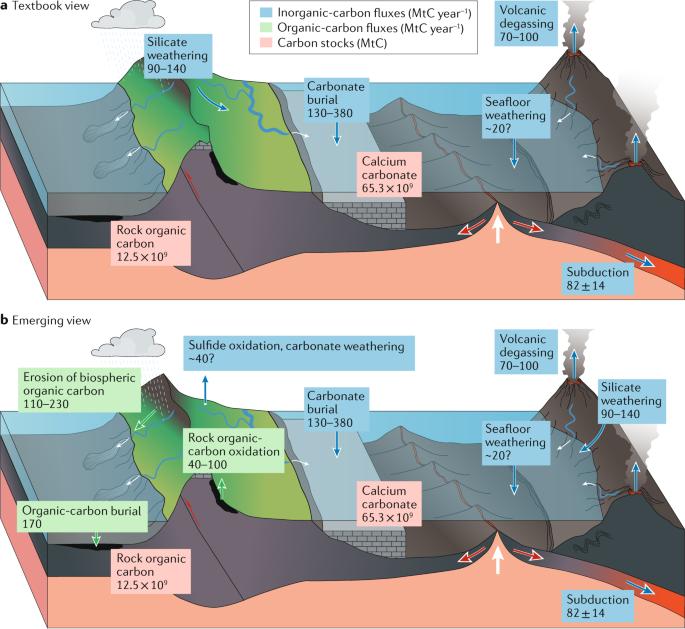Mountains, erosion and the carbon cycle
引用次数: 139
Abstract
Mountain building results in high erosion rates and the interaction of rocks with the atmosphere, water and life. Carbon transfers that result from increased erosion could control the evolution of Earth’s long-term climate. For decades, attention has focused on the hypothesized role of mountain building in drawing down atmospheric carbon dioxide (CO2) via silicate weathering. However, it is now recognized that mountain building and erosion affect the carbon cycle in other important ways. For example, erosion mobilizes organic carbon (OC) from terrestrial vegetation, transferring it to rivers and sediments, and thereby acting to draw down atmospheric CO2 in tandem with silicate weathering. Meanwhile, exhumation of sedimentary rocks can release CO2 through the oxidation of rock OC and sulfide minerals. In this Review, we examine the mechanisms of carbon exchange between rocks and the atmosphere, and discuss the balance of CO2 sources and sinks. It is demonstrated that OC burial and oxidative weathering, not widely considered in most models, control the net CO2 budget associated with erosion. Lithology strongly influences the impact of mountain building on the global carbon cycle, with an orogeny dominated by sedimentary rocks, and thus abundant rock OC and sulfides, tending towards being a CO2 source. By increasing erosion, mountain building can steer the evolution of atmospheric carbon dioxide (CO2) and global climate. This Review expands from the canonical focus on silicate weathering to consider the net carbon budget of erosion, including both CO2 sinks (silicate weathering, organic-carbon burial) and CO2 sources (oxidative weathering).

山脉、侵蚀和碳循环
造山导致高侵蚀率以及岩石与大气、水和生命的相互作用。侵蚀加剧导致的碳转移可能会控制地球长期气候的演变。几十年来,人们一直关注造山运动在通过硅酸盐风化作用汲取大气中二氧化碳(CO2)方面的假设作用。然而,现在人们已经认识到,造山运动和侵蚀作用会以其他重要方式影响碳循环。例如,侵蚀作用会调动陆地植被中的有机碳(OC),将其转移到河流和沉积物中,从而与硅酸盐风化作用一起吸收大气中的二氧化碳。同时,沉积岩的掘起可通过岩石有机碳和硫化物矿物的氧化作用释放二氧化碳。在这篇综述中,我们研究了岩石与大气之间的碳交换机制,并讨论了二氧化碳源和汇的平衡问题。研究表明,大多数模型未广泛考虑的 OC 埋藏和氧化风化作用控制着与侵蚀相关的二氧化碳净预算。岩石学对造山运动对全球碳循环的影响有很大影响,以沉积岩为主的造山运动倾向于成为二氧化碳的来源,因此,丰富的岩石 OC 和硫化物也倾向于成为二氧化碳的来源。通过增加侵蚀,造山运动可以引导大气中二氧化碳(CO2)和全球气候的演变。本综述从对硅酸盐风化的典型关注扩展到考虑侵蚀的净碳预算,包括二氧化碳汇(硅酸盐风化、有机碳埋藏)和二氧化碳源(氧化风化)。
本文章由计算机程序翻译,如有差异,请以英文原文为准。
求助全文
约1分钟内获得全文
求助全文

 求助内容:
求助内容: 应助结果提醒方式:
应助结果提醒方式:


